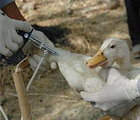 美國賓州大學醫學院研究人員發明了一種對抗禽流感(avian influenza)的疫苗注射新方法,這種疫苗會誘騙人體免疫系統,發動對抗這種疾病多種病毒株(strains)的廣泛性免疫反應,包括對抗一些免疫系統從未接觸過的病毒株。
美國賓州大學醫學院研究人員發明了一種對抗禽流感(avian influenza)的疫苗注射新方法,這種疫苗會誘騙人體免疫系統,發動對抗這種疾病多種病毒株(strains)的廣泛性免疫反應,包括對抗一些免疫系統從未接觸過的病毒株。
在他們的實驗中,接受過疫苗注射的彌猴、老鼠及雪貂在暴露在禽流感之後,都能受到保護而免於罹病及死亡。
如果這在人類身上也能證明有效,這項研究就能夠為有效準備對抗大規模禽流感爆發來鋪路。
全世界的衛生官員都在擔心H5N1禽流感病毒會突變成人直接傳人的模式而啟動流感大流行。
最近從2003年開始爆發的禽流感疫情中,人類感染H5N1的案例在15個國家被記錄下來,資料由世界衛生組織(World Health Organization,WHO)進行彙整,結果顯示曾經發生385個人類感染案例,其中有243人死亡。
這種新的疫苗注射方式透過合成的DNA(也稱為去氧核醣核酸,deoxyribonucleic acid)來傳遞疫苗。這種遺傳物質帶有所有已知生命體發育及功能運作的遺傳程序。傳統的疫苗是將一種規劃過的特定流感病毒株暴露在生物體,使生物體能產生免疫反應來對抗那種特定的病毒株。
 但是現在有一種DNA疫苗能成為生物體細胞的一部份,讓細胞擁有製造抗原所需的藍圖,這種抗原能夠誘發生物體產生對抗許多種大規模流感病毒株的免疫反應。研究人員表示,因為這些合成的DNA疫苗能夠有效地對抗多重交叉感染的病毒株,疫苗可以在大流行之前被生產及庫存起來,並在疫情爆發之時快速地被送達。
但是現在有一種DNA疫苗能成為生物體細胞的一部份,讓細胞擁有製造抗原所需的藍圖,這種抗原能夠誘發生物體產生對抗許多種大規模流感病毒株的免疫反應。研究人員表示,因為這些合成的DNA疫苗能夠有效地對抗多重交叉感染的病毒株,疫苗可以在大流行之前被生產及庫存起來,並在疫情爆發之時快速地被送達。
賓州大學病理學及實驗室醫學(pathology and laboratory medicine)教授衛訥(David Weiner)博士表示:「這是第一個顯示一種疫苗就能夠在包括靈長類的許多動物模式中誘發對抗大規模流感病毒株的研究。運用這種疫苗,我們就能產生一個單一組合且可以給予更多保護效果的大規模流感疫苗。」
 衛訥指出,禽流感是非常詭譎多變的,它不僅致死率高,也突變的很快,能夠產生許多種病毒株來躲避針對一種特殊病毒株的免疫反應。因此,要以活的或死的病毒來預先準備有效疫苗以因應單株或少數交叉感染病毒株的大規模流感是非常困難的。如何預測哪種禽流感病毒株會出現,在任何時間點都是困難的。衛訥提醒說:「我們在製造那種有效對抗特定病毒株的腳步上常常都是落後的。」
衛訥指出,禽流感是非常詭譎多變的,它不僅致死率高,也突變的很快,能夠產生許多種病毒株來躲避針對一種特殊病毒株的免疫反應。因此,要以活的或死的病毒來預先準備有效疫苗以因應單株或少數交叉感染病毒株的大規模流感是非常困難的。如何預測哪種禽流感病毒株會出現,在任何時間點都是困難的。衛訥提醒說:「我們在製造那種有效對抗特定病毒株的腳步上常常都是落後的。」
根據世界衛生組織WHO,流感病毒通常是高度物種專一性的,意思是感染單一物種(例如人類、某些種鳥類、豬隻、馬及海豹)的病毒原則上只會感染那一種物種,僅有很少數跨種感染的例子。其中一個例外便是高致病性的H5N1禽流感病毒。
A new way to vaccinate against avian influenza that tricks the immune system into mounting a broad response against multiple strains of the disease, including strains to which the immune system was never exposed, has been devised by researchers at the University of Pennsylvania School of Medicine.
In the experiments, vaccinated macaques, mice and ferrets were protected from both disease and death when exposed to avian flu.
If proven in humans, this research could lead the way to effectively prepare against an outbreak of pandemic avian flu.
Health officials around the world worry that the H5N1 bird flu virus will mutate into a form that is readly transmitted from person to person, starting an influenza pandemic.
In the latest bird flu outbreak which began in 2003, human cases of H5N1 bird flu have been documented in 15 countries. Data compiled by the World Health Organization shows 385 cases have occurred, and of these, 243 people have died.
The new vaccination method delivers the vaccine via synthetic DNA, or deoxyribonucleic acid, the hereditary material that contains the genetic instructions for the development and functioning of all known living beings.
Traditional vaccines expose a formulation of a specific strain of flu to the body so it can create immune responses against that specific strain.
But a DNA vaccine becomes part of the cell, giving it the blueprint it needs to build antigens that can induce responses targeting diverse strains of pandemic flu.
Because these synthetic DNA vaccines are effective against multiple cross strains, vaccines could be created and stockpiled, prior to a pandemic, and thus be delivered quickly in the event of an outbreak, say the researchers.
"This is the first study to show that a single DNA vaccine can induce protection against strains of pandemic flu in many animal models, including primates," says David Weiner, PhD, professor of pathology and laboratory medicine at the university.
"With this type of vaccine, we can generate a single construct of a pandemic flu vaccine that will give much broader protection," he said.
Avian flu is tricky, Weiner said. Not only is it deadly, but it mutates quickly, generating different strains that escape an immune response targeted against one single strain.
Preparing effective vaccines for pandemic flu in advance with either live or killed viruses, which protect against only one or few cross-strains, is therefore very difficult.
How to predict which strain of avian flu may appear at any time is difficult. "We are always behind in creating a vaccine that can effectively protect against that specific strain," notes Weiner.
Influenza viruses are normally highly species-specific, meaning that viruses that infect an individual species - humans, certain species of birds, pigs, horses, and seals - stay “true” to that species, and only rarely spill over to cause infection in other species, according to the World Health Organization, WHO. The one exception is the highly pathogenic H5N1 bird flu virus.
全文及圖片詳見:ENS


